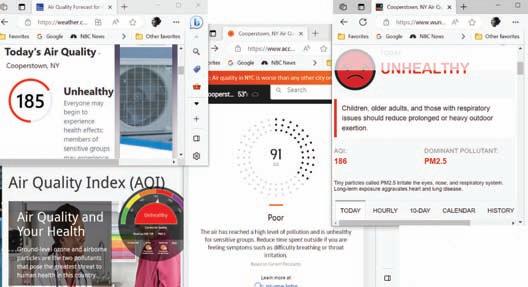
11 minute read
All

EDITORIAL
Advertisement
Farewell to a Friend
All of us here at Iron String Press were saddened last week to hear of the death of Edward W. Stack, one of our village’s most committed, industrious and indefatigable supporters, on Sunday, June 4. His passing has left a plethora of memories in our community, and we are extremely thankful for the commanding legacy, rich and fruitful, that he left us.
Ed spent his youth on Long Island, which included a nasty bout with polio in 1949 (which left its mark) and graduated from Pace College (later Pace University) on a Friday in June 1956. He began working for the only organization he was to work for, the Clark Estates, the following Monday, and spent 44 years in New York City and Cooperstown, supporting as many institutions as he could get his hands on, amusing us with many stories, encouraging us to laugh, and making things right. We laughed a lot.
His home base was Glen Head, as he spent most of his time at the Clark Estates office in New York City, but he and his wife, Chris, spent their summers in Cooperstown with their three children. It was here that Ed did so much for the Village of Cooperstown and its surrounding Otsego County. The National Baseball Hall of Fame, with its museum and library, took a large part of his time; the revered organization was expanded and renovated, in terms of its missions—becoming both a collecting and exhibiting museum as well—its square footage, and the rules of election to the Hall of Fame. Ed fought successfully for a rules change that disqualified any player on baseball’s permanently ineligible list from being considered for a plaque in the Hall.
Ed was also very supportive of the Cooperstown Farmers’ Market, offering ideas and negotiating space for the fledgling project, and of Hyde Hall, Hartwick College, Pathfinder Village, and the Mary Imogene Bassett Hospital. In 1987, Glimmerglass Opera Festival moved into its new theater and undertook filling its much-expanded audience space. As a trustee, Ed was at as many performances as his schedule allowed, and it was he who famously said, repeatedly, he so much wanted the little company to survive. He also devoted much time to the Fenimore House (now Fenimore Art Museum), and among the many projects he endorsed there, the Thaw Collection of Native American Art and its new wing were major objects of his attention. Ed’s sense of community service, his dedication to education and charity, his interest in new and evolving ideas, his determination to see them survive, his respect and enthusiasm for every person he met and for our upstate struggling not-for-profits, and his profound, unwavering sense of humor were all part of the man we so admired for half a century.
He was also a sincerely devoted father, helping his three girls navigate their futures, and running across the fields and through the forests with them to find the errant bullfrog or owl pellet that was missing from the annual scavenger-hunt list.
Among the many recipients of contributions that may be made in Ed Stack’s memory are the National Baseball Hall of Fame and Museum, Friends of Bassett and the Glimmerglass Festival. It is difficult to say which of these worthy organizations was his favorite, were he to admit to one; he worked energetically, for many years, for them all.
LETTERS TO THE EDITOR POLICY
“The Freeman’s Journal” welcomes letters to the editor that reflect the writer’s thoughts on an article or other item appearing in the paper. They must include the writer’s name, address, e-mail and telephone/ mobile number; the opinions expressed must be the writer’s own. Hostile, offensive, factually incorrect or excessively inflammatory content will not be published. The length must be no more than 250 words. The editors reserve the right to accept, reject or edit letters for clarity and space. Please send letters to: info@allotsego.com.
Smoke and the Hidden Threat to Public Health
In regard to our scientific response to the pandemic, White House COVID-19 Response Coordinator Ashish Jha has noted that we got the biology right and the social science wrong. As someone who spent three years as part of a consortium of researchers from Bassett Research Institute, Utica University, and my own SUNY Oneonta studying COVID, I can sadly attest to the accuracy of his statement. Our recent bout with smoke from the fires in Canada is a case in point.
When most people think of science, they remember the splayed-out frog from biology class or turning water into beakers of hydrogen and oxygen. These are the building blocks of our world, but our reality is further organized into what scientists call “complex adaptive systems.” All complex systems have roughly similar properties, and understanding them is what unites meteorologists, evolutionary biologists, and sociologists (like me) in a common cause.
Complex systems are composed of individual agents: Think of a single cell in your body or an antelope that is part of a herd. In social systems, each individual agent (a fancy way of saying “person”) has a unique perspective, set of beliefs, biological characteristics, etc. Through interaction with other agents, a logic that governs the system as a whole emerges in a process called, well, emergence. Simply stated, the whole is more than the sum of its parts.
Because complex systems have a seemingly infinite number of interactions among individual agents, they are notoriously difficult to predict. Scientists can understand the process of their evolution, but beyond a certain time frame our ability to account for every variable is limited.
This is largely a measurement issue: With current technology, we simply cannot know the position of every atom in the atmosphere, the thought of every person at every point in time, or which new horrifying combination of traits will emerge on the virus that causes COVID-19. Instead, scientists in these fields turn to dynamical system modeling to understand how these systems operate.
For example, in order to understand the COVID outbreak on our campus in fall 2020, Greg Fulkerson and I used a model for understanding disease spread called a SIR model (SIR stands for susceptible, infectious, recovered). Ours was quite simple, but it shows the impact of the campus leaders’ decision to test every student on campus. With no mitigation, our model predicted more than 2,000 cases in a two-week period, each with the potential to start a new outbreak somewhere else. Because university officials chose to test every student on campus, effectively changing the environment in which the virus could spread, the actual number of cases over that same period was 673. Although we have a good knowledge of how the virus spread, the populations dynamics involved with spread, and its interaction with individual behavior, the best we can do is model the spread, and if one of our assumptions is slightly off, the whole model changes.


What does this have to do with smoke and public health? Consider the Air Quality Index. It is based on a compilation of measurements of various pollutants in the atmosphere, but as with any complex system, it is only as good as the data going in.
AirNow, the federal government website, has a set of air monitors around the country, the closest one to us being in Utica. They feed the measurements into a computer and use a set of algorithms to model what the AQI is in Cooperstown. For the most part, this is also how private companies calculate the AQI, using a different set of air monitors and algorithms. Unfortunately, each website or app reports the AQI for a specific location, giving the impression that the figure reflects a direct measurement of air quality when it is actually a product of data analytics. As you can see, because each agent has a different set of inputs and algorithms, the values reported can be wildly varied.
Maureen Culbert, Richard deRosa, Caspar Ewig, Daniel Francis, Ian Kenyon, Joel J. Plue, Tom Shelby, Dan Sullivan, T. Stephen Wager, Teresa Winchester, Jamie Zvirzdin
Web Architect Ivan Potocnik Historian Tom Heitz/Sharon Stuart Legal Counsel Jill Ann Poulson
Editorial Board
Tara Barnwell, Faith Gay, Michael Moffat, Elinor Vincent, Darla M. Youngs
The direct effect on public health messaging is obvious: The appropriate actions for dealing with air pollution are different when AQI is 91 as opposed to 186, and more accurate information is needed.
There is another, more ominous, threat to health messaging: seeing such variation in reported AQI for the same location at the same time, a member of the public has good reason to question the numbers. If people learn to distrust a seemingly unassailable quantitative measure, it will lead to greater distrust of science and scientists in general. Since public health messaging requires clear messaging about complex scientific issues, this can only complicate matters. It is fair to say that none of these companies want to mislead the public, and given their unique measurement structures and algorithms, they can each have valid results that nevertheless contradict each other.
As with other social phenomena, even if every firm has positive intentions, unclear guidance and a fostering of distrust emerges from the system as people interact with multiple apps. If we want to improve messaging about public health issues, scientists across all disciplines need to better convey the benefits and limitations of what we can and cannot do.
Fig. 1. Left, top: A simple SIR model used to understand the dynamics of the SUNY Oneonta outbreak. Bottom: The effect of testing every student is reflected in the red line representing the actual number of cases, compared to the black line which represents the expected number of cases based on the SIR model. This is called “flattening the cure.”
Fig. 2. Above: An assortment of conflicting AQI values for Cooperstown at about 5 p.m. on Wednesday, June 7. From left: The Weather Channel, AirNow, AccuWeather, Weather Underground Alex Thomas is professor of sociology and executive director of the PLACES Institute at SUNY Oneonta.

THE PARTIAL OBSERVER THE SESSIOn Of THE fIRST PRESBYTERIAn CHuRCH Of COOPERSTOwn
Assault Weaponry Has No Place with Citizenry
When will enough be enough?” is the question that has been underneath an all-too-regular lament of the congregation and leaders of The First Presbyterian Church of Cooperstown, joining other such cries from communities around the state and country. In the wake of tragic news story after tragic news story, at the sight of every flag lowered to half-mast, in the midst of every gathering for prayer and solace while we grapple with the awareness of communities broken apart by gun violence, this question has been underneath it all. “When will enough be enough?” we constantly find ourselves wondering. Eventually, we reached the point when we could no longer let the question go unanswered. Members of our congregation have written to our elected officials individually; it was time to speak with a broader voice, starting with our particular faith community.
Following the mass shooting in March of 2023 in Nashville, Tennessee at a preschool connected to a “cousin church,” the Session (the elected, governing body) of First Presbyterian sent an overture to our regional governing body, The Presbytery of Utica, to pass a resolution to be distributed on behalf of the presbytery to our elected officials.
And in the midst of this process, our country sat through more mass shootings, along with a string of shootings due to heightened fear and suspicion (for instance, a car of teenagers turning around in a driveway after they mistook it for the address they were looking for). And each time, the question echoes in our broken hearts, “When will enough be enough? When will the loss of innocent life outweigh our country’s desire to uphold a right that was established before we had a standing army? Before assault-style weaponry could fire a multitude of bullets in a matter of life-changing seconds?”
The intent of this resolution from our Session is applied specifically to assault and assault-style weaponry, the kind that was created for military use due to its capacity to do little else than take mass amounts of life in a matter of seconds. Our belief is that there is no justifiable reason for such weaponry to be in civilian hands. Our resolution to the presbytery, and our message to elected officials, is solely to find a way to keep this particular weapon out of citizen hands. Nothing more, but also nothing less.
We know that there are other social issues and ills which need
210 YeARS AGO
Books for Sale by H. & e. Phinney at their Book & Stationery Store, Cooperstown—“Halyburton’s enquiry into the Principles of Modern Deists,” “Shakespeare’s Works— 8 Volumes,” “Winter in London—A novel, 2 Volumes,” “Blair’s Lectures,” “Life of Rev. Cornelius Winter,” “Works of Lady Mary Wortley Montague, 5 Volumes,” “Camilla, A novel,” “Buchan’s Domestic Medicine,” “Christ’s Second Appearing,” “Smith’s essays on the Causes of the Variety of Complexion and Figure in the Human Species,” “Fleetwood, or The new Man of Feeling,” “Baxter’s Call to the Unconverted,” and “Bennett’s Letters to a Young Lady on a Variety of Useful and Interesting Subjects.”
June 12, 1813
185 YeARS AGO
eternal vigilance is the price of liberty. The Democratic Republican Young Men of the Town of Otsego, are requested to meet at the house of C.S. Butts, in the Village of Cooperstown, on Thursday, the 14th inst., at six o’clock p.m., for the purpose of choosing delegates to represent them in the Young Men’s County Convention to be holden on Wednesday, the 27th inst., and also for the purpose of effecting a political organization of the Young Men of the town. By order of the Committee,
June 11, 1838.
160 YeARS AGO
For the Ladies: Women of the east—A Harem Interior. Miss Rogers gives a very brief and life-like picture of the interior of a harem of Mahommed Bek Abdul, the Governor of Azzebeh, whither she was invited. “They pounced upon me as if I were a new toy for them. They kissed me, one after the other, and stroked my face. They had never seen a european, and told me that no daughter of the Franks had ever entered the town before. They said: ‘Be welcome, oh sister from a far country; this house is yours and we are your servants.’ The ladies wore full, long, trousers with short, tight jackets, made of cloth or velvet, embroidered with velvet, and flowers and jewels in their head dresses. The servants wore cotton suits and the slaves red cloth. They wondered to see my plain, long dark riding dress and hat.”
June 12, 1863
110 YeARS AGO
The talking pictures in the Star Theatre Monday evening were attended by a crowd rivaled in size only by the first appearance of “Deerslayer.” The regular pictures and the banjo act were very pleasing—of the “talkies” it can only be said that they are yet in a crude state and it will be some time before theatres will install them as a permanent feature. Those shown in Cooperstown Monday were as good as any shown in the cities, having just completed an eight-month run in Boston. They came here from Albany and went from here to Cortland. The talking picture is merely a combination of a moving picture and a phonograph operated in synchronism.
June 11, 1913
60 YeARS AGO
The annual Cooperstown Central School Awards Assembly was held Friday in the high school auditorium. The Bausch and Lomb Science Award, in recognition of outstanding achievement and intellectual promise in the field of science went to Diane Hanson. The english IV Award for a student who shows competence and sensitivity in handling the english language was presented to Thomas H. Troeger. Patricia Gregory was honored for maintaining the highest average (96.2) in Bookkeeping throughout the year. Sarah Butler received the Otsego County Legal Secretaries Association Award of $10 for the student with the highest average (97.1) in Shorthand. Robert Chambers was recognized as the art student showing the most promise and ability in the Advanced Art class. Lynn e. Green, Jr. was recognized as the outstanding student in the field of history.
June 12, 1963
35 YeARS AGO
A celebration in honor of Independence Day will be held at The Farmers’ Museum July 4th. A full day of activities will be presented in the spirit of the 19th century. The program will feature a town ball game, a reenactment of a 19th century Independence Day celebration, and a parade through the museum’s village crossroads to the church. After arriving at the church there will be a reading of the Declaration of Independence by Tom Heitz.
June 15, 1988 from the noteworthy









